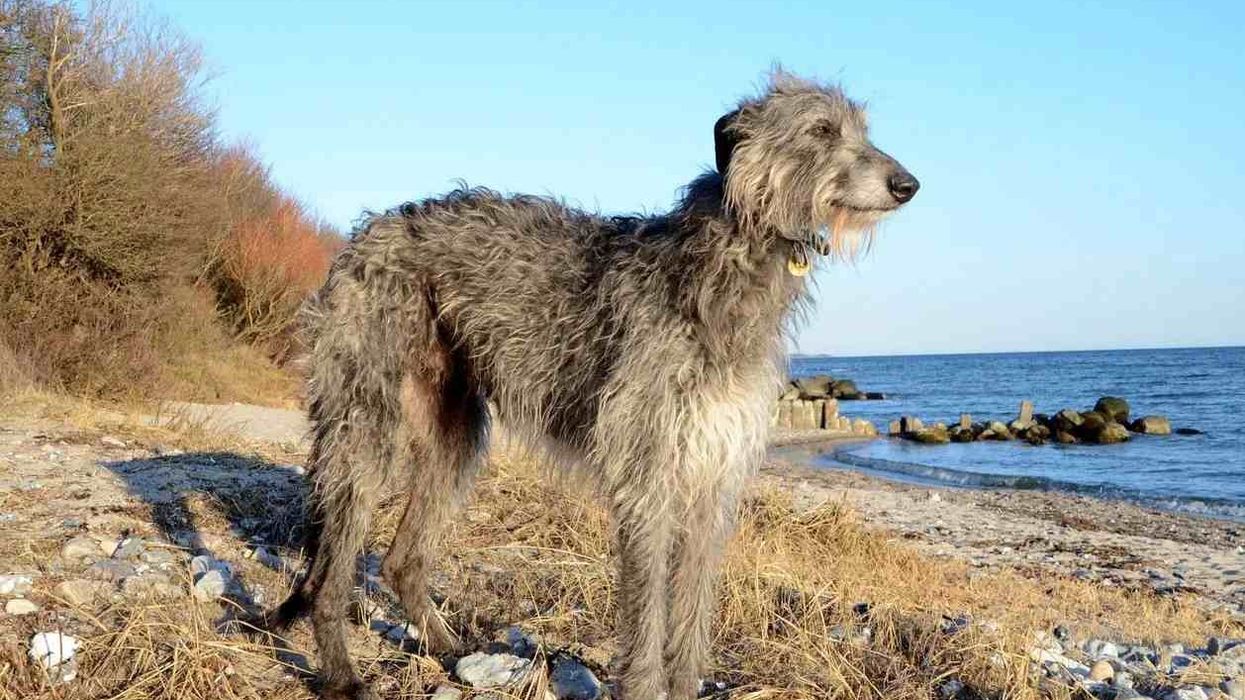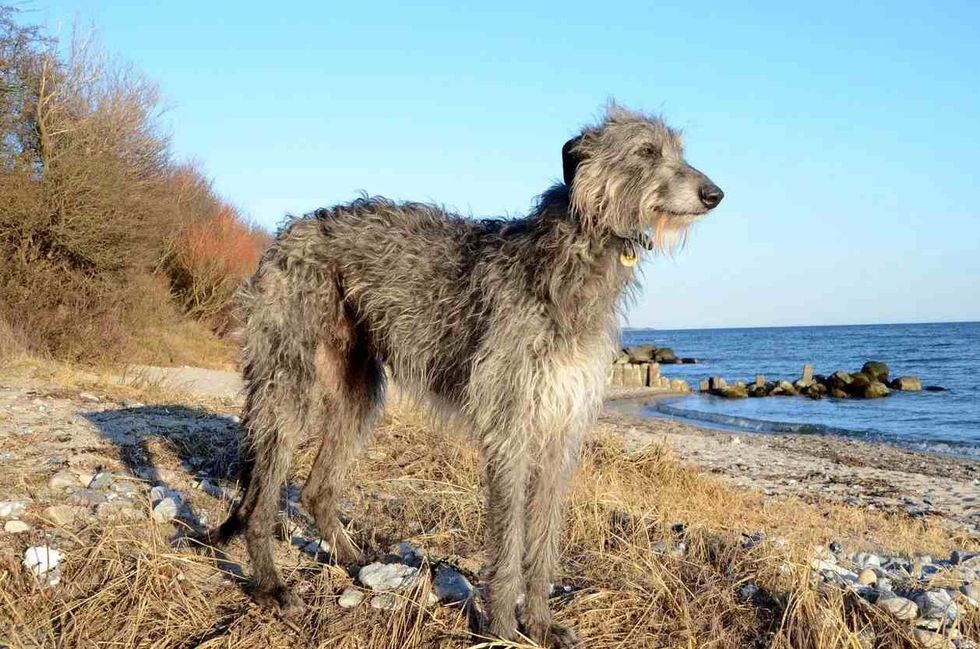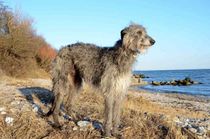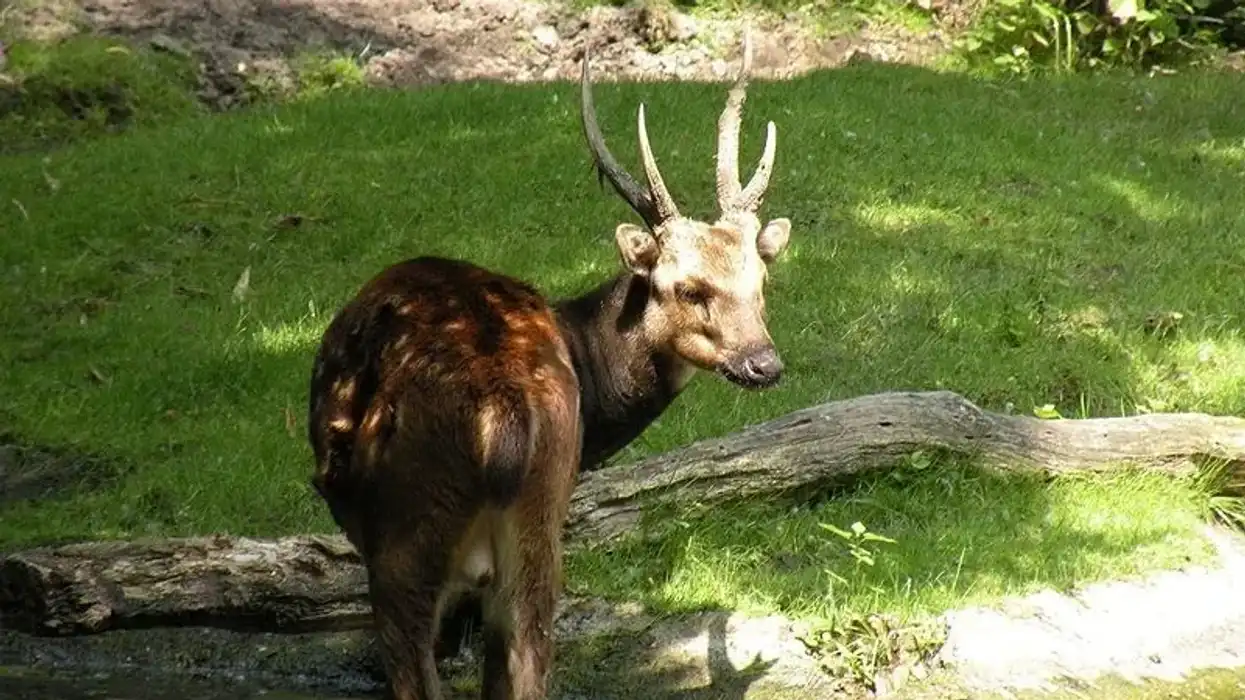Fun Scottish Deerhound Facts For Kids

The Scottish deerhound dog breed is famously known for its royal and elegant appearance. Although the history of the origin of the dog breed has no concrete evidence, it is widely accepted that these dogs were found on the Scottish grounds even before the arrival of the native Scots.
Classified as a 'hound', initially, these dogs were used for sport, that is, seeking, pursuing, and hunting down a red fawn or deer larger than its own size.
These dogs were adept at tracing deer and chasing them for a long distance before finally leaping on them. They portray a chivalrous and gentle nature despite having a huge body structure.
The Scottish deerhound breed almost disappeared around the 16th and 17th centuries but was eventually saved from extinction.
However, the dog breed was previously considered similar to the Irish wolfhounds. After gaining recognition as a separate breed in America, the Scottish deerhound club was founded in 1886.
If you enjoy reading through these Scottish deerhound facts, then you can also check out some more intriguing facts about other dog breeds like Borzoi and Great Dane.
Scottish Deerhound Interesting Facts
What type of animal is a Scottish Deerhound?
A Scottish deerhound is a dog.
What class of animal does a Scottish Deerhound belong to?
A Scottish deerhound belongs to the class of mammals.
How many Scottish Deerhounds are there in the world?
Scottish deerhounds are widely available throughout the world. However, the modern Scottish deerhounds are bred and reared just as pets to grace human homes and serve as loyal companions.
It is almost impossible to offer accurate data about the numbers in current existence. It can be said that they are an easily available dog breed across the world which means that these dogs are present in abundance.
Where does a Scottish Deerhound live?
A Scottish deerhound is available throughout the world. From the very beginning, these dogs are believed to have been loyal companions for human beings.
They live with their owner and their family members. However, they cannot adjust well in small apartments or rooms with little space. Since they have lived in human companionship from time immemorial, they cannot fend for their own lives - deerhounds need human assistance for their survival.
What is a Scottish Deerhound's habitat?
If the origin stories of the dog breed are to be believed, the homes of these dogs were the Scottish Highlands where they would be engaged in hunting stags. However, in present times, these dogs can be located in warm and cozy indoor spaces.
Who do Scottish Deerhounds live with?
A Scottish deerhound is historically known to have been an accomplice of the humans where they were used to pursue and hunt down red deer. In modern times, the dog breed generally lives with their master and their family as house pets.
This implies that they cannot thrive or survive alone, they are highly dependent on the humans for the food and care that they need.
How long does a Scottish Deerhound live?
On average, a Scottish deerhound life span ranges from 8-11 years. A healthy dog enjoys greater longevity.
How do they reproduce?
The breeding process in Scottish deerhounds begins with the attainment of the puberty stage. Once the mating process is completed, the female deerhounds need about 60-62 days to give birth to puppies after conception.
During this period the females must be kept under intensive care so that they give birth to healthy puppies. The litter size generally comprises 4-15 puppies. A puppy can be removed from its maternal care only after two to three weeks.
What is their conservation status?
The Scottish deerhounds fall under the category of unlisted species which implies that these dogs are available in good numbers and therefore not a major reason for concern. According to the International Union for Conservation of Nature Red List, these huge dogs do not find a spot under one of the currently threatened species.
Scottish Deerhound Fun Facts
What do Scottish Deerhounds look like?
Scottish deerhounds speak of majesty and elegance when it comes to appearance. These dogs are large in size with a sturdy body structure.
They possess a tapering muzzle, flat skull, folded ears, narrow and slender body with long legs and tail. These dogs come in a variety of colors like gray brindle, blue-gray, fawn, gray, yellow with a coarse wiry coat.
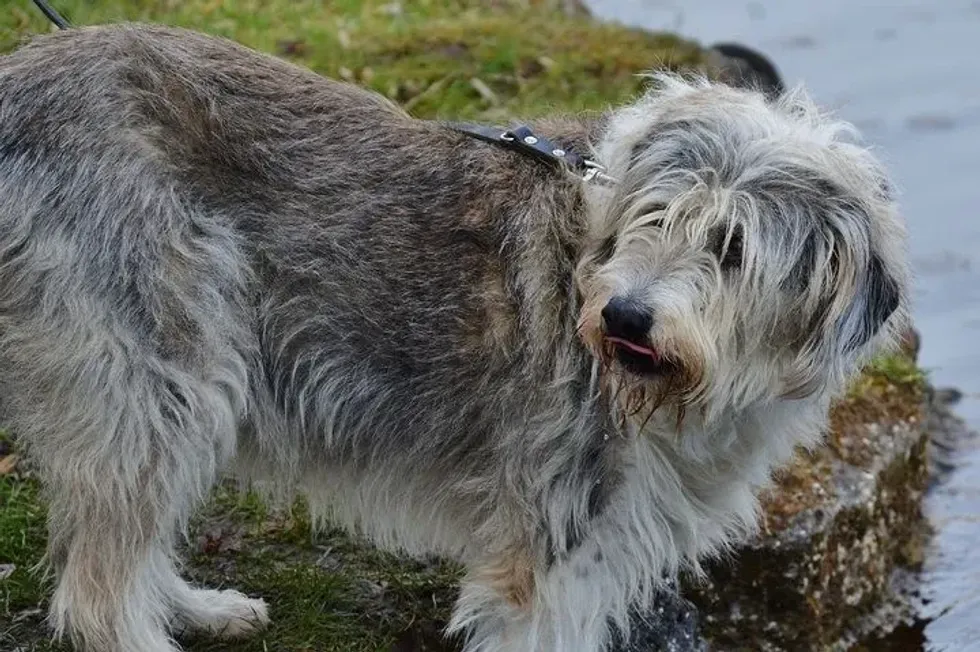
How cute are they?
Scottish deerhound puppies are the cutest! Although a Scottish deerhound is a breed of a large dog, it does not fall short in its cuteness quotient.
These dogs are extremely adorable and they love to cuddle. They have deep, emotional eyes, a fluffy fur coat with a gentle nature that makes them more lovable. Hugging a deerhound might feel like embracing a giant, fluffy bear!
How do they communicate?
Like any other dog breed, the Scottish deerhound interacts with the help of sign languages and gestures along with vocal representations of its thoughts and feelings. When these dogs are adopted and trained from their initial stages, they form a strong bonding with people and other pets alike (given that they are provided with proper social exposure).
They generally vocalize their feelings by barking, growling, whining, whimpering, howling, and making similar other sounds. They are also adept at conveying their emotions through gestures.
For instance, they would happily wag their tails and express their excitement or joy. They might even extend a paw and call you for a walk or play outside!
How big is a Scottish Deerhound?
Scottish deerhounds fall under the category of large dog breeds and they are one of the largest dogs all over the world. Although they are not as large as the Irish wolfhound, the average height of a Scottish deerhound ranges from 28-32 in (71-81 cm) when measured from the shoulder.
The males stand at around 30-32 in (76-81 cm) while the height of the females goes above 28 in (71 cm).
In comparison, the height of the Irish wolfhounds is generally more than 32 in (81 cm) so they are bigger. A Scottish deerhound is undoubtedly bigger than a golden retriever or a Great Pyrenees.
How fast can a Scottish Deerhound run?
Scottish deerhounds are one of the fastest runners and they can sprint at a speed of 28 mph (45 kmph). These dogs have the reputation of covering long distances in pursuit of the deer they located and hunted down.
These dogs are highly energetic and would surely love to follow you for a morning walk or a long run. However, they might grow to be lethargic if not provided with proper outdoor exercise.
How much does a Scottish Deerhound weigh?
Normally the weight of a Scottish deerhound spans between 75-110 lb (34-50 kg). While the males are comparatively heavier than the females with a weight of 85-110 lb (39-50 kg), the weight of their counterparts falls between 75-95 lb (34-43 kg).
These dog breeds are bulky and weigh some more pounds than the greyhounds. The weight of these dogs reveals how bulky and heavy they can be. You might consider the fact that they cannot be simply carried to places.
What are their male and female names of the species?
The male name of a Scottish deerhound is a dog while the females are called a bitch.
What would you call a baby Scottish Deerhound?
A baby of the Scottish deerhounds is regarded as a puppy. They might also be called a pup affectionately.
What do they eat?
A Scottish deerhound is omnivorous which implies that its diet must be enriched with nutrients. A wholesome diet is necessary for these large dogs comprising an adequate quantity of proteins, vitamins, minerals, carbohydrates, and other necessary nutrients.
They can be offered dry dog food that is readily available in the market but a diet fulfilled with animal protein is essential. Their diet must comprise a balanced proportion of fruits and vegetables, raw meat, soft bones, fish, and others to ensure good health.
Scottish deerhound puppies can be served three to four bowls of meal per day whereas the grownups must be served two bowls. A regular intake of 2000-2500 calories is crucial for an adult dog of this breed.
Are they slobbery?
Scottish deerhounds are generally not known to be slobbery. They do not drool unless they have some problem. In case they drool excessively and unnaturally, they must be rushed to the nearby vet as early as possible.
Would they make a good pet?
A Scottish deerhound can make an excellent loyal partner and pet given that its needs and requirements are satisfied. Although they were used to hunt down deer, they are absolutely gentle and do not portray aggressiveness (unless they feel provoked or threatened).
These dogs can mingle and bond well with kids and other pets when provided with good social training.
Did you know...
The American Kennel Club identified and proclaimed the Scottish deerhound as a distinct dog breed in the year 1886.
In the early 19th century the deerhounds almost became extinct. It was only for a group of few farmers and the brothers named Archibald and Duncan Mcneill that the dog breed exists to date. They initiated a program that focused on breeding the dogs and reviving their original hunting traits.
The Scottish deerhound had served as a loyal pet for the noble and royal members of the Scotland society. They were often referred to as the 'Royal Dog of Scotland'. They were maintained and taken as pets mainly by the highland Chieftains.
Although they were adept at chasing wild deer, the Scottish deerhound may not show great interest in playing fetch. However, they might just enjoy running around.
As legends would have it, the dog breed is said to have existed even before the arrival of Scots.
Scottish Deerhound vs. Irish Wolfhound
The Scottish deerhound shares many similar traits with the Irish Wolfhound as both these dog breeds are descendants of the hound family, and they both were on the verge of extinction.
While the origin of the Scottish deerhound dog breed has been attributed to the grounds of Scotland, the Irish wolfhound is said to have originated in Ireland. The origin history of both breeds is unknown and is restricted to the legendary tales and myths that have been handed down through ages.
Both these hounds were bred for the purpose of hunting.
Nevertheless, the Irish wolfhounds were meant for hunting down the wolves while the Scottish deerhound was targeted at the stags. You might be unable to differentiate between the two breeds based on their appearance but these are a few distinct features that separate the two.
According to the American Kennel Club, the Irish wolfhound possess the tallest height among all dog breeds.
The Irish wolfhound comes with a muscular build while the deerhound is slender with a larger and heavier bone structure. Both breeds are available in similar shades of color and wiry coat but another point of distinction is their tail.
While the deerhounds have a tapering long tail, the tail of the wolfhounds is curl up slightly at the tip.
Having your own Scottish Deerhound
The average price of a Scottish deerhound puppy ranges between $1000-$2500. The cost is largely dependent on the availability, gender, bone structure, health, fur coat, and other significant features of the breed, that is, the better the quality of health, the more it would cost.
Deerhounds are widely available for adoption. You can buy one from a nearby pet shop or from a professional breeder.
However, a background study of a Scottish deerhound temperament, its dietary and grooming requirements, ailments, and other important facts is essential. A Scottish deerhound does not shed a lot but it has grooming requirements like an occasional bath, dental care, and ear and eye checkups.
It is also necessary to adopt puppies from a professional and expert breeder. A deerhound may develop certain adverse health conditions that can potentially prove to be fatal.
Like any other flesh and blood animal, the Scottish deerhound also has several health issues. These dogs are prone to certain health conditions and ailments like hypothyroidism, hip dysplasia, obesity, gastric torsion, elbow dysplasia, osteosarcoma, and cystinuria. Some of these diseases, if not treated on time, might prove to be life-threatening for the dog.
The diseases and health problems can be kept at bay by engaging them in daily exercise, proper diet, grooming, and care. Since these dogs generally have a great energy level, their spirits must be channelized in the right way.
A regular exercise regimen of about half an hour would do the job. These royal dogs have the potentiality to become great pets.
Here at Kidadl, we have carefully created lots of interesting family-friendly animal facts for everyone to discover! Learn more about some other mammals including Saluki, or greyhound.
You can even occupy yourself at home by drawing one on our Scottish Deerhound coloring pages.
We Want Your Photos!
More for You
Sources
https://en.wikipedia.org/wiki/Scottish_Deerhound
https://www.dimensions.com/element/scottish-deerhound
https://www.cheatsheet.com/culture/these-are-the-fastest-dog-breeds-in-the-world.html/
http://www.deerhound.co.uk/breed-standard/history.htm
https://deerhound.org/the-breed/history-of-the-scottish-deerhound/
See All
Bachelor of Arts specializing in Journalism and Mass Communication, Postgraduate Diploma in Sports Management

Moumita DuttaBachelor of Arts specializing in Journalism and Mass Communication, Postgraduate Diploma in Sports Management
A content writer and editor with a passion for sports, Moumita has honed her skills in producing compelling match reports and stories about sporting heroes. She holds a degree in Journalism and Mass Communication from the Indian Institute of Social Welfare and Business Management, Calcutta University, alongside a postgraduate diploma in Sports Management.
Bachelor of Technology specializing in Computer Science Engineering

Shray SharmaBachelor of Technology specializing in Computer Science Engineering
As an aspiring web and app developer, Shray has a passion for working with promising startups. He is currently pursuing a Bachelor's degree in Computer Science from Maharaja Surajmal Institute Of Technology while gaining experience in digital marketing. Shray has already earned a Google Analytics Certification and is well-equipped to handle analytics and data management tasks. He has also served as a marketing manager at Parallax Virtual Arts, where he oversaw the company's social media, content, and SEO strategies. Shray's goal is to create engaging content that resonates with audiences and offers valuable insights.
Disclaimer
1) Kidadl is independent and to make our service free to you the reader we are supported by advertising. We hope you love our recommendations for products and services! What we suggest is selected independently by the Kidadl team. If you purchase using the Buy Now button we may earn a small commission. This does not influence our choices. Prices are correct and items are available at the time the article was published but we cannot guarantee that on the time of reading. Please note that Kidadl is a participant in the Amazon Services LLC Associates Program, an affiliate advertising program designed to provide a means for sites to earn advertising fees by advertising and linking to Amazon. We also link to other websites, but are not responsible for their content.
2) At Kidadl, we strive to recommend the very best activities and events. We will always aim to give you accurate information at the date of publication - however, information does change, so it’s important you do your own research, double-check and make the decision that is right for your family. We recognise that not all activities and ideas are appropriate for all children and families or in all circumstances. Our recommended activities are based on age but these are a guide. We recommend that these ideas are used as inspiration, that ideas are undertaken with appropriate adult supervision, and that each adult uses their own discretion and knowledge of their children to consider the safety and suitability. Kidadl cannot accept liability for the execution of these ideas, and parental supervision is advised at all times, as safety is paramount. Anyone using the information provided by Kidadl does so at their own risk and we can not accept liability if things go wrong.
3) Because we are an educational resource, we have quotes and facts about a range of historical and modern figures. We do not endorse the actions of or rhetoric of all the people included in these collections, but we think they are important for growing minds to learn about under the guidance of parents or guardians.
